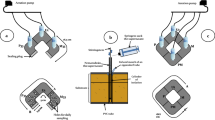Abstract
Aquaria containing clean sand received a continuous supply of seawater from Santa Rosa Sound, Florida, USA, mixed with known concentrations (7, 76 and 622 μg l-1) of pentachlorophenol (PCP). After 9 weeks, nematodes accounted for 87% of the total meiofauna. Nematode biomass and densities were greatest in aquaria exposed to 76 μg PCP l-1 and were least in aquaria exposed to 622 μg PCP l-1. Epistrate feeders were abundant in control aquaria and aquaria exposed to 7 and 76 μg PCP l-1, but not in aquaria exposed to 622 μg PCP l-1. Selective deposit feeders were not abundant in the control aquaria and aquaria exposed to 7 μg PCP l-1, but comprised 19% of the nematodes in aquaria exposed to 76 μg PCP l-1 and 61% in aquaria exposed to 622 μg PCP l-1.
Similar content being viewed by others
Literature Cited
Bevenue, A. and H. Beckman: Pentachlorophenol: discussion of its properties and its occurrence as a residue in human and animal tissues. Residue Rev. 19, 83–134 (1967)
Boström, S.L. and R.G. Johansson: Effects of pentachlorophenol on enzymes involved in energy metabolism in the liver of the eel. Comp. Biochem. Physiol. 41B, 359–369 (1972)
Boucher, G.: Premières données écologiques sur les nématodes libres marins d'une station de vas terrigene côtière de Banyuls. Vie Milieu 23B, 69–100 (1973)
Coull, B.C.: Species diversity and faunal affinities of meiobenthic Copepoda in the deep sea. Mar. Biol. 14, 48–51 (1972)
—: Estuarine meiofauna: a review: trophic relationships and microbial interactions. In: Estuarine microbial ecology, pp 499–512. Ed. by H. Stevenson and R.R. Colwell. Columbia, S.C.: University of South Carolina Press 1973
Crandall, C.A. and C.T. Goodnight: The effect of various factors on the toxicity of sodium pentachlorophenate to fish. Limnol. Oceanogr. 4, 53–56 (1959)
Fenchel, T.: The ecology of marine microbenthos. I. The quantitative importance of ciliates as compared with metazoans in various types of sediments. Ophelia 4, 121–137 (1967)
Field, J.G. and G. McFarlane: Numerical methods in marine ecology. I. A quantitative “similarity” analysis of rocky shore samples in False Bay, South Africa. Zoologica africa. 3, 119–137 (1968)
Fountaine, J.E., P.B. Joshipura and P.N. Keliher: Some observations regarding pentachlorophenol levels in Haverford Township, Pennsylvania. Wat. Res. 10, 185–188 (1976)
Ganapati, P.N. and A.L.N. Sarma: The meiofauna and pollution in Visakhapatnam Harbour. Curr. Sci. 42, 724–725 (1973)
Goodnight, C.J.: Toxicity of sodium pentachlorophenate and pentachlorophenol to fish. Ind. Engng Chem. ind. Edn 34, 868–872 (1942)
Gray, J.S.: The effects of pollution on sand meiofauna communities. Thalassia jugosl. 7, 79–86 (1971)
Hansen, D.J.: Aroclor 1254: effect on composition of developing estuarine animal communities in the laboratory. Contr. mar. Sci. Univ. Tex. 18, 19–33 (1974)
Holmberg, B., S. Jensen, A. Larsson and K. Lewander: Metabolic effects of technical pentachlorophenol (PCP) on the eel Anguilla anguilla. Comp. Biochem. Physiol. 43B, 171–183 (1972)
Hummon, W.D.: Effects of DDT on longevity and reproductive rate in Lepidodermella squammata (Gastrotricha, Chaetonotida). Am. Midl. Nat. 92, 327–339 (1974)
Lorenzen, S.: Die Nematodenfauna der Sublitoralen Region der Deutschen Bucht, insbesondere in Titan-Abwassergebiet bei Helgoland. Veröff. Inst. Meeresforsch. Bremerh. 14, 305–327 (1974)
Marcotte, B.M. and B.C. Coull: Pollution, diversity and meiobenthic communities in the North Adriatic (Bay of Piran, Yugoslavia). Vie Milieu 24B, 281–300 (1974)
McIntyre, A.D.: The ecology of marine meiobenthos. Biol. Rev. 44, 245–290 (1969)
Mukherji, S.K.: Use of pentachlorophenol as an algicide in paddy fields in West Bengal. Weed Res. 12, 389–390 (1972)
Pequegnat, W.E.: Meiobenthos ecosystems as indicators of the effects of dredging. In: Estuarine research, Vol. 11. pp 573–584. Ed. by L.E. Cronin. New York: Academic Press 1975
Pielou, E.C.: The measurement of diversity in different types of biological collections. J. theor. Biol. 13, 131–144 (1966)
Rappe, C. and C.A. Nilsson: An artifact in the gas chromatographic determination of impurities in pentachlorophenol. J. Chromat. 67, 322–357 (1972)
Shim, J.C. and L.S. Self: Toxicity of agricultural chemicals to larvivorous fish in Korean rice fields. Nettai Igaku 15, 123–130 (1973)
Sokal, R.R. and F.J. Rohlf: Biometry, 776 pp. San Francisco: W.H. Freeman Press 1969
Tagatz, M.E., J.M. Ivey, J.C. Moore and M. Tobia: Effects of pentachlorophenol on development of estuarine communities. J. Toxic. envir. Hlth 3, 1–6 (1977)
Thompson, J.F.: Manual of analytical methods for the analysis of pesticide residues in human and environmental samples, Prepared by U.S. EPA, Environmental Toxicology Division. Triangle Park, North Carolina: U.S. Environmental Protection Agency 1974
Tietjen, J.H.: The ecology of shallow water meiofauna in two New England estuaries. Oecologia (Berl.) 2, 251–291 (1969)
—: Population distribution and structure of the free-living nematodes of Long Island Sound. Mar. Biol. 43, 123–136 (1977)
Vermeer, J., R.W. Risebrough, A.L. Spaans and L.M. Reynolds: Pesticide effects on fishes and birds in rice fields of Surinam, South America. Envir. Pollut. 7, 217–236 (1974)
Ward, A.R.: Studies on the sublittoral freeliving nematodes of Liverpool Bay. I. The structure and distribution of the nematode populations. Mar. Biol. 22, 53–66 (1973)
Weinbach, E.C.: The influence of pentachlorophenol on oxidative and glycolytic phosphorylation in snail tissues. Archs Biochem. Biophys. 64, 129–143 (1956)
Wieser, W.: Die Beziehung zwischen Mundhöhlengestalt, Ernährungsweise und Vorkommen bei freilenbenden marinen Nematoden. Ark. Zool. 4, 439–484 (1953)
—: Benthic studies in Buzzards Bay. II. The meiofauna. Limnol. Oceanogr. 5, 121–137 (1960)
Yasuraoka, K. and Y. Hosaka: The problem of resistance of Oncomelania snail to sodium pentachlorophenate. Jap. J. med. Sci. Biol. 24, 393–394 (1971)
Author information
Authors and Affiliations
Additional information
Communicated by J.M. Lawrence, Tampa
Rights and permissions
About this article
Cite this article
Cantelmo, F.R., Rao, K.R. Effect of pentachlorophenol (PCP) on meiobenthic communities established in an experimental system. Mar. Biol. 46, 17–22 (1978). https://doi.org/10.1007/BF00393815
Accepted:
Issue Date:
DOI: https://doi.org/10.1007/BF00393815




